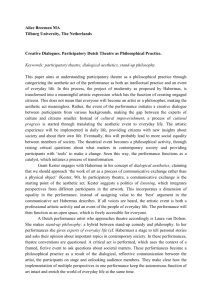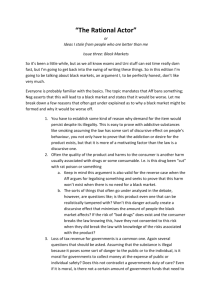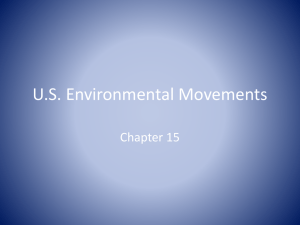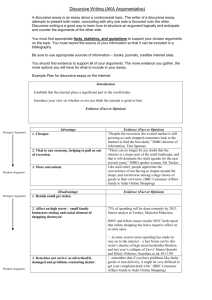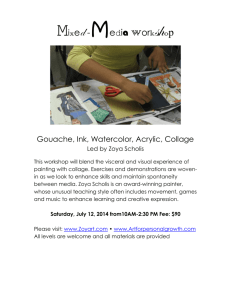Conversation Pieces: The Role of Dialogue in Socially
advertisement
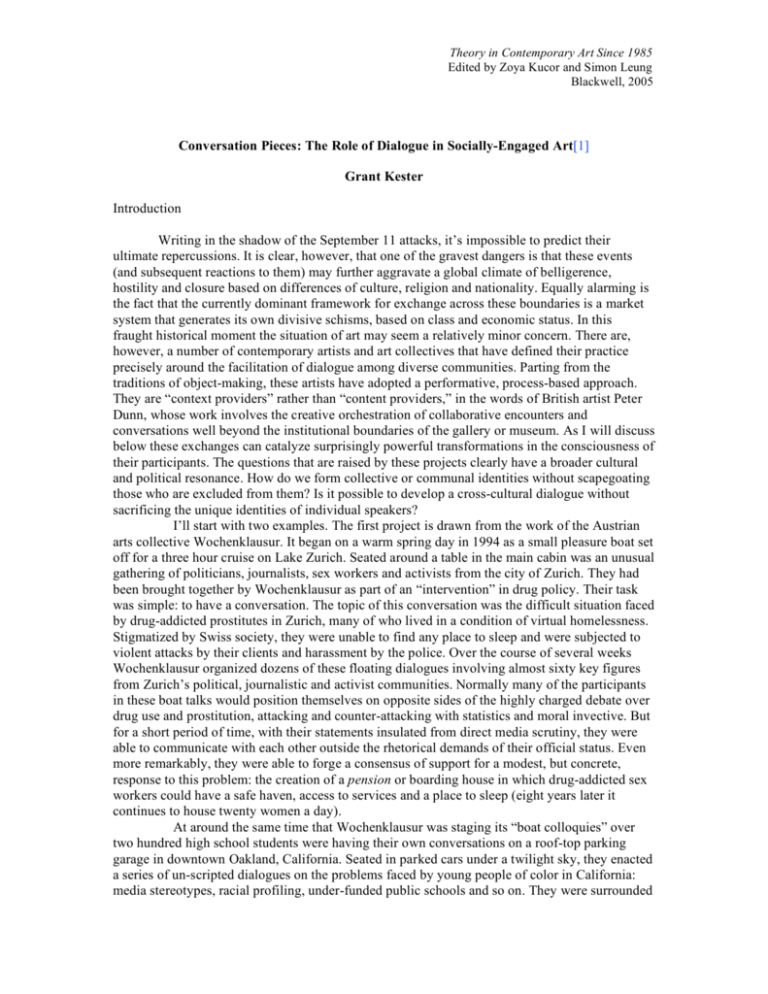
Theory in Contemporary Art Since 1985 Edited by Zoya Kucor and Simon Leung Blackwell, 2005 Conversation Pieces: The Role of Dialogue in Socially-Engaged Art[1] Grant Kester Introduction Writing in the shadow of the September 11 attacks, it’s impossible to predict their ultimate repercussions. It is clear, however, that one of the gravest dangers is that these events (and subsequent reactions to them) may further aggravate a global climate of belligerence, hostility and closure based on differences of culture, religion and nationality. Equally alarming is the fact that the currently dominant framework for exchange across these boundaries is a market system that generates its own divisive schisms, based on class and economic status. In this fraught historical moment the situation of art may seem a relatively minor concern. There are, however, a number of contemporary artists and art collectives that have defined their practice precisely around the facilitation of dialogue among diverse communities. Parting from the traditions of object-making, these artists have adopted a performative, process-based approach. They are “context providers” rather than “content providers,” in the words of British artist Peter Dunn, whose work involves the creative orchestration of collaborative encounters and conversations well beyond the institutional boundaries of the gallery or museum. As I will discuss below these exchanges can catalyze surprisingly powerful transformations in the consciousness of their participants. The questions that are raised by these projects clearly have a broader cultural and political resonance. How do we form collective or communal identities without scapegoating those who are excluded from them? Is it possible to develop a cross-cultural dialogue without sacrificing the unique identities of individual speakers? I’ll start with two examples. The first project is drawn from the work of the Austrian arts collective Wochenklausur. It began on a warm spring day in 1994 as a small pleasure boat set off for a three hour cruise on Lake Zurich. Seated around a table in the main cabin was an unusual gathering of politicians, journalists, sex workers and activists from the city of Zurich. They had been brought together by Wochenklausur as part of an “intervention” in drug policy. Their task was simple: to have a conversation. The topic of this conversation was the difficult situation faced by drug-addicted prostitutes in Zurich, many of who lived in a condition of virtual homelessness. Stigmatized by Swiss society, they were unable to find any place to sleep and were subjected to violent attacks by their clients and harassment by the police. Over the course of several weeks Wochenklausur organized dozens of these floating dialogues involving almost sixty key figures from Zurich’s political, journalistic and activist communities. Normally many of the participants in these boat talks would position themselves on opposite sides of the highly charged debate over drug use and prostitution, attacking and counter-attacking with statistics and moral invective. But for a short period of time, with their statements insulated from direct media scrutiny, they were able to communicate with each other outside the rhetorical demands of their official status. Even more remarkably, they were able to forge a consensus of support for a modest, but concrete, response to this problem: the creation of a pension or boarding house in which drug-addicted sex workers could have a safe haven, access to services and a place to sleep (eight years later it continues to house twenty women a day). At around the same time that Wochenklausur was staging its “boat colloquies” over two hundred high school students were having their own conversations on a roof-top parking garage in downtown Oakland, California. Seated in parked cars under a twilight sky, they enacted a series of un-scripted dialogues on the problems faced by young people of color in California: media stereotypes, racial profiling, under-funded public schools and so on. They were surrounded Theory in Contemporary Art Since 1985 Edited by Zoya Kucor and Simon Leung Blackwell, 2005 by over a thousand Oakland residents, who along with representatives of local and national news media, had been invited to “over hear” these conversations. In this event, organized by the California artist Suzanne Lacy, along with Annice Jacoby and Chris Johnson, Latino and African American teenagers were able to take control of their self-image and to transcend the onedimensional clichés promulgated by mainstream news and entertainment media (e.g., the young person of color as sullen, inarticulate gang-banger). These dialogues led in turn to other collaborations and other conversations, including a six week long series of discussions between high school students and members of the Oakland Police Department (OPD) that resulted in the creation of a videotape used by the OPD as part of its community policing training program. These projects mark the emergence of a body of contemporary art practice concerned with collaborative, and potentially emancipatory, forms of dialogue and conversation. While it is common for a work of art to provoke dialogue among viewers this typically occurs in response to a finished object. In these projects conversation becomes an integral part of the work itself. It is re-framed as an active, generative process that can help us speak and imagine beyond the limits of fixed identities and official discourse. While this collaborative, consultative approach has deep and complex roots in the history of art and cultural activism (e.g., Helen and Newton Harrison in the US, Artists Placement Group in the UK, and the tradition of community-based art practice) it has also energized a younger generation of practitioners and collectives, such as Ala Plastica in Buenos Aires, Superflex in Denmark, Maurice O’Connell in Ireland, MuF in London, Huit Facettes in Senegal, Ne Pas Plier in Paris, and Temporary Services in Chicago, among many others. Although global in scope, this work exists largely (albeit, not entirely) outside the international network of art galleries and museums, curators and collectors.[2] Thus, Iñigo Manglano Ovalle’s Tele Vecindario project was developed on the south side of Chicago; Littoral has been active in the hill farming regions of the Bowland Forest in the north of England, and the Singapore-born artist Jay Koh has produced works in Thailand, Burma, and Tibet. What unites this disparate network of artists and arts collectives are a series of provocative assumptions about the relationship between art and the broader social and political world, and about the kinds of knowledge that aesthetic experience is capable of producing. For Lacy, who is also active as a critic, this work represents a “new genre” of public art. UK-based artists/organizers Ian Hunter and Celia Larner employ the term “Littoral” art, to evoke the hybrid or in-between nature of these practices. French critic Nicolas Bourriaud has coined the term “relational aesthetic” to describe works based around communication and exchange. Homi K. Bhabha writes of “conversational art,” and Tom Finkelpearl refers to “dialogue-based public art.”[3] For reasons that will become apparent I will be using the term "dialogical" to describe these works. The concept of a dialogical art practice is derived from the Russian literary theorist Mikhail Bakhtin who argued that the work of art can be viewed as a kind of conversation; a locus of differing meanings, interpretations and points of view.[4] 1. Discourse as Modernism’s Other The interactions that are central to these projects all require some provisional discursive framework through which the various participants can exchange insights and observations. It may be spoken or written, or it may involve some form of physical or conceptual collaboration. But the idea that a work of art should solicit participation and involvement so openly, or that its form should be developed in consultation with the viewer is antithetical to dominant beliefs in modern and postmodern art theory.[5] By the early twentieth century the consensus among advanced artists and critics was that, far from communicating with viewers, the avant-garde work of art should radically challenge their faith in the very possibility of rational discourse. This tendency is based on the assumption that the shared discursive systems on which we rely for our knowledge of the world (linguistic, visual, etc.) are dangerously abstract and violently objectifying. Art’s role Theory in Contemporary Art Since 1985 Edited by Zoya Kucor and Simon Leung Blackwell, 2005 is to shock us out of this perceptual complacency, to force us to see the world anew. This shock has borne many names over the years: the sublime, alienation effect, L’Amour fou, and so on. In each case the result is a kind of somatic epiphany that catapults the viewer outside of the familiar boundaries of a common language, existing modes of representation, and even their own sense of self. While the projects I’m discussing here do encourage their participants to question fixed identities, stereotypical images, and so on, they do so through a cumulative process of exchange and dialogue, rather than a single, instantaneous shock of insight, precipitated by an image or object. These projects require a paradigm shift in our understanding of the work of art; a definition of aesthetic experience that is durational rather than immediate. It was, of course, a central tenet of Enlightenment philosophy (evident in the writing of Kant, Wolff, Hume, and Shaftesbury) that aesthetic experience constituted an idealized form of communication. It is easier to grasp the significance of this claim if one considers the cultural function of art during the eighteenth century. Baroque painting served as the decorative backdrop for the social life of the drawing room or salon. In a similar manner, fetes and perambulations in Georgian-era landscape gardens were intended to initiate shared reflection: to teach visitors about the harmonious relationship between the social and the natural worlds. Painters and landscape architects shared a common symbolic vocabulary with their patrons. The objects and environments they created facilitated exchanges that were central to the life of a (admittedly elitist) community of viewers. [6] While preserving the ceremonial and performative dimension of earlier art practices designed to encourage veneration and obeisance (e.g., courtly or liturgical art), these works patterned that performance around a more open-ended pedagogical interaction. With the emergence of an artistic avant-garde in the mid-nineteenth-century the survival of authentic art seemed to require the severing of this potentially stultifying interdependence of artist and viewer through shock, attack, and dislocation. The symbiosis of aristocratic patronage was replaced by a critical, adjudicatory relationship, heavily informed by artists’ identification with the revolutionary rhetoric of the nascent working-class. Increasingly, avant-garde art sought to challenge, rather than corroborate, conventional systems of meaning, whether through Realism’s introduction of taboo subjects such as poverty and prostitution, Impressionism’s rejection of the norms of academic realism, Cubism’s even more violent dismantling of these norms, or Dadaism’s embrace of the absurd. Avant-garde art must define itself as different from other forms of culture precisely by being difficult to understand, shocking or disruptive (except now, contra Schiller’s return to “wholeness”, a Lyotardian “ontological dislocation” becomes the therapeutic antidote to a centered Cartesian subjectivity). Lying behind this rhetoric of shock was a more complex (and occasionally paradoxical) motive: to make the viewer more sensitive and responsive to the specific characteristics of nature, other beings, and to otherness in general. Avant-garde artists of various stripes believed that Western society (especially its urban, middle-class) had come to view the world in a violently objectifying manner associated with the growing authority of positivistic science and the profit-driven logic of the marketplace. The rupture provoked by the avant-garde work of art is necessary to shock viewers out of this perspective and prepare them for the nuanced and sensitive perceptions of the artist, uniquely open to the natural world. This tradition has both enabled and constrained the possibilities of art practice in the modern period. The tension that exists between the movement towards open-ness, sensitivity to difference and vulnerability and the paradoxical drive to “master” the viewer through a violent attack on the semantic systems through which they situate themselves in the world, remains unresolved. Thus Jean-François Lyotard disparages art which is based on the assumption that the public “will recognize. . . will understand, what is signified.”[7] Lyotard, like Clement Greenberg earlier in the century, defines avant-garde art as the other of kitsch. If kitsch traffics in reductive or simple concepts and sensations then avant-garde art will be difficult and complex; if kitsch’s preferred mode is a viewer-friendly “realism” then avant-garde art will be abstract, “opaque” and Theory in Contemporary Art Since 1985 Edited by Zoya Kucor and Simon Leung Blackwell, 2005 “unpresentable”. In each case the anti-discursive orientation of the avant-garde artwork, its inscrutability and resistance to interpretation, is juxtaposed to a cultural form that is perceived as easy or facile (advertising, propaganda, etc.). Lyotard can’t conceive of a discursive form that is not always, already contaminated by the problematic model of “communication” embodied in advertising and mass-media. The viewer or audience-member is, in turn, always defined by their epistemological lack: their susceptibility to the siren song of vulgar and facile forms of culture. The artists and groups I’m discussing here ask whether it’s possible for art to re-claim a less violent relationship with the viewer while also preserving the critical insights that aesthetic experience can offer into objectifying forms of knowledge. 2. A Dialogical Aesthetic If, as I am suggesting, the evaluative framework for these projects is no longer centered on the physical object, then what is the new locus of judgment? I would contend that it resides in the condition and character of dialogical exchange itself. Given this focus I consider Jürgen Habermas’s work to be an important resource for the development of a dialogical model of the aesthetic, especially his attempt to construct a model of subjectivity based on communicative interaction. Habermas differentiates "discursive" forms of communication, in which material and social differentials (of power, resources, and authority) are bracketed, and speakers rely solely on the compelling force of superior argument, from more instrumental or hierarchical forms of communication (e.g., those found in advertising, business negotiations, religious sermons, and so on). These self-reflexive (albeit time-consuming) forms of interaction are not intended to result in universally binding decisions, but simply to create a provisional understanding (the necessary precondition for decision-making) among the members of a given community when normal social or political consensus breaks down. Thus their legitimacy is not based on the universality of the knowledge produced through discursive interaction, but on the perceived universality of the process of discourse itself. The encounters theorized by Habermas take place in the context of what he famously defined as the "public sphere". Participants in a public sphere must adhere to certain rules necessary to insulate this discursive space from the coercion and inequality that constrain human communication in normal daily life. Thus, according to Habermas, "every subject with the competence to speak is allowed to take part in discourse," "everyone is allowed to question any assertion whatsoever," "everyone is allowed to introduce any assertion whatsoever," and "everyone is allowed to express his or her attitudes, desires and needs."[8] This egalitarian interaction cultivates a sense of "solidarity" among discursive co-participants, who are, as a result, "intimately linked in an inter-subjectively shared form of life".[9] While there is no guarantee that these interactions will result in a consensus we nonetheless endow them with a provisional authority that influences us towards mutual understanding and reconciliation. Further, the very act of participating in these exchanges makes us better able to engage in discursive encounters and decision-making processes in the future.[10] In attempting to present our views to others we are called upon to articulate them in a more systematic manner. In this way we are led to see ourselves from the other's point of view, and are thus, at least potentially, able to be more critical and self-aware about our own opinions. This self-critical awareness can lead, in turn, to a capacity to see our views, and our identities, as contingent, processual, and subject to creative transformation. While I don't want to suggest that the dialogical projects I've outlined illustrate Habermas's discourse theory, I do believe it can be productively employed as one component of a larger analytic system. First, Habermas's concept of an identity forged through social and discursive interaction can help us understand the position taken up by groups like Wochenklausur. We typically view the artist as a kind of exemplary bourgeois subject, Theory in Contemporary Art Since 1985 Edited by Zoya Kucor and Simon Leung Blackwell, 2005 actualizing his or her will through the heroic transformation of nature or the assimilation of cultural difference—alchemically elevating the primitive, the degraded, and the vernacular into great art. Throughout, the locus of expressive meaning remains the radically autonomous figure of the individual artist. A dialogical aesthetic suggests a very different image of the artist; one defined in terms of open-ness, of listening and a willingness to accept dependence and intersubjective vulnerability. The semantic productivity of these works occurs in the interstices between the artist and the collaborator. Habermas's concept of an "ideal speech situation" captures an important, and related, aspect of these works, which we can see in Wochenklausur's boat trips on Lake Zurich. The collaborators in this project (the attorneys, councilors, activists, editors, and so on who embarked on these short journeys) are constantly called upon to speak in a definitive and contentious manner in a public space (the courtroom, the editorial page, the parliament) in which dialogue is viewed as a contest of the wills (cf. Lyotard's model of "agonistic" communication). On the boat trips they were able to speak, and listen, not as delegates and representatives charged with defending a priori "positions" but as individuals sharing an extensive collective knowledge of the subject at hand; at the least these external forces were considerably reduced by the demand for self-reflexive attention created by the ritual and isolation of the boat trip itself. Moreover, the consensus they reached on a response to the drug problem in Zurich was not intended as a universally applicable solution to the “drug crisis,” but rather, as a pragmatic response to a very specific aspect of that problem; the homelessness experienced by prostitutes. Drawing on Habermas's concept of discourse, there are two areas in which I would differentiate a dialogical aesthetic from a more traditional aesthetic model. The first area concerns claims of universality. Early modern philosophers rejected the idea of an aesthetic consensus achieved through actual dialogue with other subjects because it would fail to provide a sufficiently "objective" standard of judgment or communicability. In large measure this was due to the fact that they were writing in the epistemological shadow of a declining, but still resonant, theological world view. As a result the philosophical systems that hoped to compete with this perspective tended to simply replace one form of reassuringly transcendent authority (God) with another (reason, sensus communis, etc.). A dialogical aesthetic does not claim to provide, or require, this kind of universal or objective foundation. Rather, it is based on the generation of a local consensual knowledge that is only provisionally binding and that is grounded precisely at the level of collective interaction. Thus, the insights that are generated from the conversations of the high school students in The Roof is on Fire or Wochenklausur’s boat talks are not presented as emblematic of some timeless humanist essence, in the way that the sculptures of Phidias or Picasso's Guernica are typically treated in art history. The second difference between a dialogical and a conventional model of the aesthetic concerns the specific relationship between identity and discursive experience. In the Enlightenment model of the aesthetic, the subject is prepared to participate in dialog through an essentially individual and somatic experience of "liking". It is only after passing through, and being worked on by, the process of aesthetic perception that one's capacity for discursive interaction is enhanced (one literally becomes more open-minded following an encounter with a work of art, and thus, a more competent participant in social discourse). In a dialogical aesthetic, on the other hand, subjectivity is formed through discourse and inter-subjective exchange itself. Discourse is not simply a tool to be used to communicate an a priori "content" with other already formed subjects, but is itself intended to model subjectivity. This brings us to a complex point regarding the specific way in which Habermas defines discursive interaction. There are of course a number of criticisms one might make of Habermas's model, several of which relate to the bracketing of difference that is a pre-condition for participation in the public sphere. The most relevant criticism of Habermas, from the perspective of dialogical art practice, relates to his definition of the public sphere as a space of contending opinions and interests, in which the clash Theory in Contemporary Art Since 1985 Edited by Zoya Kucor and Simon Leung Blackwell, 2005 of forceful argumentation results in a final winning position that can compel the assent of the other parties. Discursive participants may have their opinions challenged, and even changed, but they enter into, and depart from, discourse as ontologically stable agents. Habermas implies that as rational subjects we respond only to the "illocutionary force" of the better argument or "good reasons".[11] But why should we necessarily respond to reason? What precisely makes an argument "good"? With reference to what, or whose, standard, values or interest is this superior strength or legitimacy determined? Further, what incentive do all these forceful speakers have to suspend their suasive campaigning in order to simply listen? How do we differentiate an assent won by rhetorical attrition from true understanding? One set of answers can be found in attempts to define a distinctly feminist model of epistemology. In their study Women's Ways of Knowing (1986) Mary Field Belenky and her co-authors identify what they term "connected knowing"; a form of knowledge based not on counterpoised arguments, but on a conversational mode in which each interlocutor works to identify with the perspective of the others.[12] This "procedural" form of knowledge is defined by two interrelated elements. First, it is concerned with recognizing the social imbededness and context within which others speak, judge and act. Rather than holding them accountable to some ideal or generalized standard, it attempts to situate a given discursive statement in the specific material conditions of the speaker. This involves a recognition of the speakers’ history (the events or conditions that preceded their involvement in a given discursive situation) and their position relative to modes of social, political and cultural power both within the discursive situation and outside it (thus acknowledging the operative force of the oppression and inequality that is ostensibly bracketed—and hence disavowed—in the Habermasian public sphere). The second characteristic of connected knowing involves the re-definition of discursive interaction in terms of empathetic identification. Rather than entering into communicative exchange with the goal of representing "self" through the advancement of already formed opinions and judgments, a connected knowledge is grounded in our capacity to identify with other people. It is through empathy that we can learn not simply to suppress self-interest through identification with some putatively universal perspective, or through the irresistible compulsion of logical argument, but to literally re-define self: to both know and feel our connectedness with others. In a follow up volume to Women's Way of Knowing (Knowledge, Difference and Power, 1996), Patrocinio Schweickart notes Habermas's tendency to "overvalue" argumentation as a form of knowledge production, and his inability to conceive of listening itself as active, productive and complex as speaking: "there is no recognition of the necessity to give an account of listening as doing something. . .the listener is reduced in Habermas's theory to the minimal quasi-speaking role of agreeing or disagreeing, silently saying yes or no."[13] Empathy is, of course, subject to its own kind of ethical and epistemological abuse. However, I also feel that a concept of empathetic insight is a necessary component of a dialogical aesthetic. Further, I would contend that precisely the pragmatic, physical process of collaborative production that occurs in the works I'm discussing (involving both verbal and bodily interaction) can help to generate this insight, while at the same time allowing for a discursive exchange that can acknowledge, rather than exile, the non-verbal. This empathetic insight can be produced along a series of axes. The first occurs in the rapport between artists and their collaborators, especially in those situations in which the artist is working across boundaries of race, ethnicity, gender, sexuality or class. These relationships can, of course, be quite difficult to negotiate equitably, as the artist often operates as an outsider, occupying a position of perceived cultural authority. This second axis of empathetic insight occurs among the collaborators themselves (with or without the mediating figure of the artist). Here the dialogical project can function to enhance solidarity among individuals who already share a common set of material and cultural circumstances (e.g., work with trade unions by artists such as Fred Lonidier in California or Theory in Contemporary Art Since 1985 Edited by Zoya Kucor and Simon Leung Blackwell, 2005 Carole Condé and Karl Beveridge in Canada). The final axis is produced between the collaborators and other communities of viewers (often subsequent to the actual production of a given project). Dialogical works can challenge dominant representations of a given community, and create a more complex understanding of, and empathy for, that community among a broader public. Of course these three functions—solidarity creation, solidarity enhancement, and the counter-hegemonic—seldom exist in isolation. Any given project will typically operate in multiple registers. Suzanne Lacy’s The Roof is on Fire project, which I discussed earlier, provides a useful example of collaboratively generated empathetic insight. In The Roof is on Fire, the space of the car, and the performative nature of the piece itself, provided the students with a stage on which to speak to each other as co-inhabitants of a specific culture and environment and, implicitly, to a generalized audience (whether the actual audience of over one thousand residents who attended the performance or the viewing public that saw coverage of the piece in the local and national media) that could function as a rhetorical stand-in for a dominant culture that is far more comfortable telling young people of color what to think than it is with hearing what they have to say. The process of listening that is of such central importance in dialogical projects is evidenced here both in Lacy's extensive discussions with the students in developing the project and in the attitude of open-ness encouraged in the viewer/over-hearer by the work itself. On the one hand this project demonstrates the empathetic and collaborative insight generated between Lacy and young people from quite different cultural backgrounds (and among the young people themselves). At the same time, it provides a space for identification between the students and the viewers of the work. One of the byproducts of the performance, in which Lacy's collaborators consistently expressed their concern over confrontations with the police in their daily lives, was a series of discussions between police and young people in Oakland that took place over several weeks. Lacy's goal was to create a "safe" discursive space (somewhat reminiscent of Wochenklausur's boat trips) in which young people could speak honestly to the police about their fears and concerns, and in which both police and young people could begin to identify with each other as individuals rather than abstractions (the "gangsta" or the "cop"). As Lacy writes: "The changes in body language of the ten officers and fifteen youth who met weekly over two months marked a transition from stereotypes to dimensional personalities. I found my own perceptions changing as I encountered police in cars and young people in baggy jeans. Were they one of my friends, someone I know?".[14] Conclusion: Criticism and Collectivity Dialogical practices require a common discursive matrix (linguistic, textual, physical, etc.) through which their participants can share insights, and forge a provisional sense of collectivity. As I pointed out in the introduction, however, forms of collective identity are anathema to the avant-garde tradition. “The idea of community,” according to Critical Art Ensemble, “is without doubt the liberal equivalent of the conservative notion of ‘family values’—neither exists in contemporary culture and both are grounded in political fantasy.”[15] There is, of course, good reason to remain skeptical of essentialist models of community that require the assertion of a monolithic collectivity over and against the specific identities of its constituent members, and those who are seen as outside its (arbitrary) boundaries. There is a somewhat Manichean quality to some of these criticisms, however, as they establish an extremely stringent standard for politically acceptable models of collective experience and action. Any attempt to operate through a shared identity (the “Gay Community,” the “Chicano Community,” etc.) is condemned as a surrender to the ontological equivalent of kitsch. In her recent book One Place after Another critic Miwon Kwon evokes a stark contrast between "bureaucratic" community art projects that engage in proscribed forms of political representation and agency (the “community of mythic Theory in Contemporary Art Since 1985 Edited by Zoya Kucor and Simon Leung Blackwell, 2005 unity” as she describes it), and an art practice that is concerned precisely with calling community into question through a critical epiphany intended to produce non-essentialist subjects.[16] If any collective identity is inherently corrupt, then the only legitimate goal of collaborative practice is to challenge or unsettle the viewer’s reliance on precisely such forms of identification. I would contend that identity is somewhat more complex than this formulation allows, and that it is possible to define oneself through solidarity with others while at the same recognizing the contingent nature of this identification. A recent project by the Nigerian artist Toro Adeniran-Kane (Mama Toro) demonstrates the capacity of tightly knit communities to approach difference from a position of dialogical openness rather than defensive hostility, forming provisional alliances across boundaries of race, ethnicity and geography. The project, A Better Life for Rural Women, was created as part of the "ArtBarns: After Kurt Schwitters" exhibition organized in the U.K. by Projects Environment (now Littoral) in the summer of 1999. 'Toro was born and raised in Nigeria, but has been living in Manchester for many years. The Art Barns project was inspired by the existence of a Kurt Schwitters installation, produced during his exile in England during WWII, in a barn located on a Lancashire farm. A number of artists were given the opportunity to produce site-specific works in barns in the hill-farming region of the Bowland Forest. For her ArtBarns project, 'Toro (working with Manchester artist Nick Fry) used the traditions of Nigerian wall painting to transform the barn interior into a performance space which was used for a variety of dances and other activities by African women who traveled to Bowland from Manchester during the course of the exhibition (Manchester has a large African immigrant population). It is important to note that 'Toro defined her role as an artist not simply in terms of the creation of the wall painting, but also through the facilitation of dialogical exchange. This performative dimension was amplified through a series of conversations that took place between women from Manchester's African community and the hill farming families. These dialogues, which were held in the kitchen of one of the farms, led to the shared recognition that the hill farming community and the African immigrant community had much in common. Many of the women came from small farming villages in Somalia, Nigeria and the Sudan and were more familiar with the rhythms of work and life in the Bowland Forest than they were with the urbanized lifestyle of Manchester. In this exchange neither the hill farmers nor the women from Manchester felt compelled to surrender their existing identities (of nationality, race, ethnicity, etc.) in order to constitute a new, provisional community based around their shared material circumstances and experiences (the spatio-cultural context of the farming village). A frequent topic of discussion in these dialogues was the limited access that the African women had to fresh produce. Living in Manchester they were often forced to shop at over-priced grocery stores filled with pre-packaged and refined food, and little in the way of fresh vegetables and other staples that would have formed the core of their diet back home. They were particularly concerned about growing health problems in Manchester's African immigrant community due to this restricted diet. One of the concrete outcomes of their conversations in Bowland was the formation of a buying cooperative that would allow them to purchase food directly from the farming community there, thus saving the farmers the money that would have been lost to middle-men, and insuring the women access to fresh produce at a reasonable cost.[17] Collective identities are not only, or always, essentializing. In this project the African immigrant and hill farming communities were able to retain a coherent sense of cultural and political identity while also remaining open to the transformative effects of difference through dialogical exchange. Toro’s project, along with recent works by Ala Plastica, Ernesto Noriega, Littoral, Temporary Services, and Wochenklausur, among others, suggest a more nuanced model of collective identity and action; one that steers cautiously between the Scylla of essentialist closure and the Charybdis of a rootless skepticism. Theory in Contemporary Art Since 1985 Edited by Zoya Kucor and Simon Leung Blackwell, 2005 Grant Kester, University of San Diego, California, 2004 [1] An earlier version of this essay was published in Variant #9 (Winter 1999-2000). Some of this material also appears in my forthcoming book Conversation Pieces: Community and Communication in Modern Art (University of California Press, 2004). [2] In recent year this work has begun to attract the attention of the mainstream art world, as evidenced by curator Okwui Enwezor’s inclusion of the Senegalese collective Huit Facettes in Documenta XI (2002). [3]Lacy develops the idea of “new genre” public art in Mapping the Terrain: New Genre Public Art (Seattle: Bay Press, 1995). The term "Littoral" is taken from a series of conferences organized over the last several years devoted to the presentation and analysis of activist art practices. For more information see the Littoral website: http://www.littoral.org.uk/index.htm. Also see Nicolas Bourriaud, L'esthétique Relationnelle (Dijon: Les Presses du Réel, 1998), Homi K. Bhabha, “Conversational Art,” Conversations at the Castle: Changing Audiences and Contemporary Art, Mary Jane Jacobs editor, with Michael Brenson (Cambridge: MIT Press, 1998), pp.38-47, and Tom Finkelpearl, “Five Dialogues on Dialogue-Based Public Art Projects,” Dialogues in Public Art (Cambridge: MIT Press, 2000), pp.270-275. [4] See Mikhail Bakhtin, "Author and Hero in Aesthetic Activity" and "Art and Answerability" in Art and Answerability: Early Philosophical Essays by M.M. Bakhtin, edited by Michael Holquist and Vadim Liapunov, translated and notes by Vadim Liapunov, supplement translated by Kenneth Brostrom (Austin: University of Texas Press, 1990). Critic Suzi Gablik develops the concept of a “dialogical” approach to art making in her book The Reenchantment of Art (New York: Thames and Hudson, 1991). [5]This attitude is not confined to writing on more conventional media. Here is critic Gene Youngblood discussing the aesthetics of digital video: “we need only remember that art and communication are fundamentally at cross-purposes . . . art is always non-communicative: it is about personal vision and autonomy; its aim is to produce non-standard observers." Gene Youngblood, "Video and the Cinematic Enterprise" (1984) in Ars Electronica: Facing the Future, a Survey of two Decades, edited by Timothy Druckrey with Ars Electronica (Cambridge: MIT Press, 1999), p.43. [6] See, for example, Tom Williamson, Polite Landscapes: Gardens and Society in EighteenthCentury England (Baltimore: Johns Hopkins University Press, 1995) and Mary Vidal, Watteau’s Painted Conversations: Art, Literature, and Talk in Seventeenth- and Eighteenth Century France (New Haven: Yale University Press, 1992). [7] Jean-François Lyotard, “What is Postmodernism?,” The Postmodern Condition: A Report on Knowledge (Minneapolis: University of Minnesota Press, 1984), p.76. [8]Jürgen Habermas, "Discourse Ethics: Notes on a Program of Philosophical Justification" in Moral Consciousness and Communicative Action, trans. by Christian Lenhardt and Shierry Weber Nicholson (Cambridge, MA: MIT Press, 1991), p.89. Bruce Barber at the Nova Scotia College of Art and Design has also explored the implications of Habermas for socially engaged art. In his essay “The Gift in Littoral Art Practice,” Barber uses Habermas’s concept of “communicative action” to elucidate recent projects by Wochenklausur, REPO History, Istvan Theory in Contemporary Art Since 1985 Edited by Zoya Kucor and Simon Leung Blackwell, 2005 Kantor and others. Versions of this essay have been published in Fuse, vol.19, no.2 (Winter 1996) and in Intervention: Post-Object and Performance Art in New Zealand in 1970 and Beyond, Jennifer Hay, editor (Christchurch: Robert MacDougall Art Gallery and Annex Press, 2000), pp.49-58. [9]Jürgen Habermas, "Justice and Solidarity," Philosophical Forum 21 (1989-90), p.47. [10]Mark Warren describes this as the "self-transformation" thesis in Habermas's work. Mark E. Warren, "The Self in Discursive Democracy" The Cambridge Companion to Habermas, edited by Stephen K. White (Cambridge: Cambridge University Press, 1995), p.172, 178. [11]See Jürgen Habermas, "Some Distinctions in Universal Pragmatics," Theory and Society 3 (1976), pp.155-167, and "Discourse Ethics: Notes on a Program of Philosophical Justification," p.90. [12]Mary Field Belenky, Blythe McVicker Clinchy, Nancy Rule Goldberger and Jill Mattuck Tarule, Women's Ways of Knowing: The Development of Self, Voice and Mind (New York: Basic Books, 1986). Also see Nöelle McAfee’s novel attempt to reconcile Habermas’s notion of a communicative identity with Julia Kristeva’s work on split subjectivity in Habermas, Kristeva and Citizenship (Ithaca: Cornell University Press, 2000). [13]Patrocinio P. Schweickart, "Speech is Silver, Silence is Gold: The Asymmetrical Intersubjectivity of Communicative Action," in Knowledge, Difference and Power: Essays Inspired by Women's Ways of Knowing, edited by Nancy Rule Goldberger, Jill Mattuck Tarule, Blythe McVicker Clinchy and Mary Field Belenky (New York: Basic Books, 1996), p.317. [14]Suzanne Lacy, "The Roof is on Fire" at the National Endowment for the Arts web site: http://204.178.35.192/artforms/Museums/Lacy.html [15] Critical Art Ensemble, “Observations on Collective Cultural Action” Variant 15 (Summer 2002), http://www.variant.ndtilda.co.uk/15texts/cae.html [16] Miwon Kwon, One Place After Another: Site Specific Art and Locational Identity (Cambridge: MIT Press, 2002), p.118. [17]The Bowland Initiative, a government-funded hill farming support agency, has given Littoral and 'Toro a contract to develop "Healthy Farms and Healthy Foods," a marketing and cultural exchange program designed to expand on the urban/rural exchanges that 'Toro initiated with her ArtBarns work. See the Littoral web site: http://www.littoral.org.uk/.
